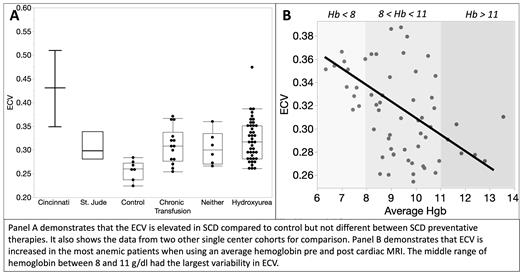Introduction
Cardiovascular disease is a leading cause of morbidity and mortality in patients with sickle cell disease (SCD) as they age.Contrast-enhanced cardiac MRI has been utilized to evaluate myocardial fibrosis by calculating the extracellular matrix volume fraction (ECV) from pre and post-contrast T1 mapping. Recent research in both animal and human models reveal that SCD patients have elevated ECV suggestive of myocardial fibrosis and is associated with diastolic dysfunction. The effects of current first-line therapies, chronic transfusions (CTT) or hydroxyurea (HU), on myocardial fibrosis are unknown and at present, there is conflicting data regarding their benefits. At our institution, SCD patients are treated early with either hydroxyurea, chronic transfusions, or both. We aimed to determine whether current disease-modifying therapies differentially affect myocardial fibrosis.
Methods
This was a single-center, retrospective cohort study of chronically transfused SCD patients and SCD patients on HU and/or CTT at Children's Hospital of Los Angeles between 2017 and 2022 aiming to assess clinical biomarkers associated with elevated ECV in sickle cell disease. This study was reviewed and approved by the Children's Hospital Los Angeles Institutional Review Board. All patients underwent cardiac MRI for clinical assessment of myocardial iron, cardiac enlargement, and myocardial fibrosis. Continuous variables are expressed as mean±standard deviation for normally distributed data and median [interquartile range] for non-normally distributed data. Parametric and non-parametric testing were used where appropriate and c-square testing was used for categorical variables.
Results
A total of 63 SCD patients, mean age 17.3±5.9 years (range 5-36yo), who underwent contrast-enhanced cardiac MRI imaging between 2017 and 2022 were included in this study: 27 CTT; 43 HU; and 7 healthy participants, mean age 15.4±2.4 years. There was no difference in age between treatment groups, nor healthy and SCD participants. There were 6 SCD patients not on any therapy and 13 patients on both. The ECV was elevated in SCD versus healthy (31.3% [27.9, 35] vs 26% [23.7,27.2], P=0.0003). There was no significant difference between the ECV values of patients on CTT, HU, both or no therapy, P=0.56 (Fig.1A). There was no difference in average length of therapy between CTT or HU, mean 10.4±4.9 vs 10.2±5.2 years and no association between length of therapy and ECV. We found positive correlation of E/A ratio with ECV in patients with SCD regardless of therapy (Spearmans rho 0.34, P=0.008), suggesting an association with left ventricular (LV) restrictive physiology. ECV was associated with increased WBC count (rho +0.28, P=0.03), AST (rho +0.3, P=0.02), decreased GFR (P=0.02), and decreased hemoglobin (rho -0.41, P=0.0013) (Fig.1B), while there was a trend toward increased urine microalbumin (rho +0.41, P=0.09).
Discussion
Fibrosis is likely due to prolonged, continuous exposure to inadequate myocardial oxygen supply and cardiac microvascular disease. Amelioration of myocardial fibrosis likely requires consistent, effective CTT or HU therapy as suggested by the Cincinnati/CHLA study. The HU patients in that study had documented high MCV or HbF over many years before ECV was measured. St Jude's study was prospective but follow-up was only 2 years and not compared to an untreated or poorly treated cohort. The sum of these studies suggests that protection from fibrosis may only be seen with continual protection from anemia/microvascular disease. This hypothesis remains to be proven. While we did not see a differential effect of hydroxyurea vs. chronic transfusion therapy, it is important to put this data into the context of SCD therapies and their indications. CTT is generally reserved for the most severe vascular disease phenotypes, such as stroke. Hydroxyurea is often prescribed but not always adhered to. The ECV range in our cohort was lower than that found in the original Cincinnati cohort, mean 44%±8, but similar to that found in the St. Jude cohort, median 30% [IQR 28,34] (Fig.1A). Lastly, elevated ECV correlates with anemia, a modifiable risk factor; restrictive LV physiology; and decreased estimated GFR, which may hint at similar etiologies. In summary, ECV is a clinically relevant cardiovascular biomarker and current preventative therapies may ameliorate but not abrogate myocardial fibrosis.
Disclosures
Coates:Agios Pharmaceuticals: Consultancy; Bristol Myers Squibb: Consultancy; Chiesi: Consultancy. Wood:Philips Medical Systems: Other: Support-In-Kind, Research Funding; Imago Biosciences: Consultancy; Hillhurst: Consultancy; Agios: Consultancy; Celgene: Consultancy; Pharmacosmos: Consultancy. Detterich:Alcor Scientific: Other: Scientific Advisory Board.


